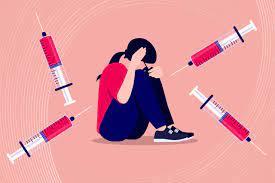Fabricated Information and Hesitancy: A Global Challenge for COVID-19 Vaccination
By: MZA
The COVID-19 pandemic cohort is accosting a severe challenge to implement mass vaccination around the world. Due to the misleading and fabricated information, vaccine hesitancy is impeding the battle against the pandemic. During a pandemic outbreak or any public health emergency, the role of media is conspicuous, regrettably serious infringement has been found for disseminating COVID-19 information. This fabricated news overwhelms an inept Individual resulting in skepticism towards the entire vaccination (Tagliabue et al., 2020). The aftermath of the COVID-19 pandemic was considered as the “tsunami” of mental illness (Tandon, 2020) and the prediction is being explicit through the anti-vaccination manifesto around the world. For instance, numerous Americans are not willing to take the vaccine; their skepticism is induced by the impetuous development of the vaccine and political jugglery. The analogous skepticism has found in the H1N1 vaccine in 2010, where people were reluctant on the same ground (Hopkins, 2020).
In the initial stage of the COVID-19 outbreak fuzzy, erroneous, and contradictory statements from the health authority confused the mass people. The emptiness of accurate knowledge and interpretations of non-specialists overwhelm the people to understand the pandemic meticulously (Tagliabue et al., 2020). The lack of reliable information continues in the vaccine development and implementation phase. However, the heterogeneous anti-vaccination groups continue spreading propaganda and misleading information focusing on natural health remedies and mistrusting medical research (Mills et al., 2020). The same report revealed misleading information is characterized by people’s mistrust of medical science and authority, pharmaceutical companies, facile interpretation of the disease, emotion-driven decision, and developing information bubbles.
Apart from the information phenomenon, it is essential to understand the human factors behind vaccine hesitance. Betsch et al. (2015) identified three influencing factors responsible for vaccine hesitance. Firstly, convenience human factor that featured with inertia. Usually, people would not take the vaccine if there is no proximity to the vaccination center. Secondly, complacence tends individuals to perceive personal low risk due to young age and healthy body. This optimism bias makes them believe the vaccination unnecessary. Thirdly, the confidence, that reveals people’s distrust of vaccine in the ground of inadequate trials.
During the early stage of mass vaccination, authorities are confronting a new challenge of fear of needle or belonephobia. Usually, belonephobia may induce while vaccination and prevails higher among the youth (Nir et al., 2003). Phobia and fear of the needle are being considered as another significant prevailing motive of COVID-19 vaccination. There is no way to avoid the needle since the immunization will be completed by injecting two doses in 21 day intervals.
Recommendations
Fabricated and misleading information prevails the onset of PTSD and stress (Dong and Zheng, 2020), also it has the likelihood to amplify further anxiety for a new strain of pandemic (Tagliabue et al., 2020). To avoid confusion and hesitancy, the following measures would be considered:
- The development of the COVID-19 vaccine was at an extreme pace due to its fatality. In such cases, people have absolute mistrust. People’s trust can be reclaimed through proper information dissemination. Institutions that are involved in developing vaccines should open all vaccine related information, therefore, people can understand the whole process of development and its efficiency.
- Politicians, influencers, relevant medical professionals can contribute to beat the infodemic.
- An open dialogue will help to fill the knowledge gap and voiding the anti-vaccination movement.
- People with belonephobia can be treated by cognitive behavior therapy, clinical hypnotherapy, and another relaxation exercise.
References
Betsch, C., Böhm, R., Chapman, G. B., 2015. Using Behavioral Insights to Increase Vaccination Policy Effectiveness. Policy Insights from the Behavioral and Brain Sciences, 2(1), 61-73. https://doi.org/10.1177/2372732215600716
Dong, M., Zheng, J., 2020. Letter to the editor: Headline stress disorder caused by Netnews during the outbreak of COVID‐19. Health Expectations, 23(2), 259-260. . https://doi.org/10.1111/hex.13055
Hopkins, J., 2020. A Covid-19 Vaccine Problem: People Who Are Afraid to Get One. [online] 28 Aug. Available at: https://www.wsj.com/articles/covid-19-vaccine-hesitancy-is-a-growing-concern-for-researchers-health-officials-11598607002 [Accessed 21 Dec. 2020].
Mills, M., Rahal, C., Brazel, D., Yan, J., Gieysztor, S., 2020. COVID-19 Vaccine Deployment: Behaviour, Ethics, Misinformation and Policy Strategies. [online] 10 Nov. Available at: https://www.socialscienceinaction.org/resources/covid-19-vaccine-deployment-behaviour-ethics-misinformation-and-policy-strategies/ [Accessed 21 Dec. 2020]
Nir, Y., Potasman, I., Sabo, E., Paz, A., 2003. Fear Of Injections In Young Adults: Prevalence And Associations. The American Journal of Tropical Medicine and Hygiene, 68(3), 341-344. https://doi.org/10.4269/ajtmh.2003.68.341
Tagliabue, F., Galassi, L., Mariani, P., 2020. The “Pandemic” of Disinformation in COVID-19. SN Comprehensive Clinical Medicine, 2(9), 1287-1289. . https://doi.org/10.1007/s42399-020-00439-1
Tandon, R., 2020. COVID-19 and mental health: Preserving humanity, maintaining sanity, and promoting health. Asian Journal of Psychiatry, 51, 102256. . https://doi.org/10.1016/j.ajp.2020.102256

